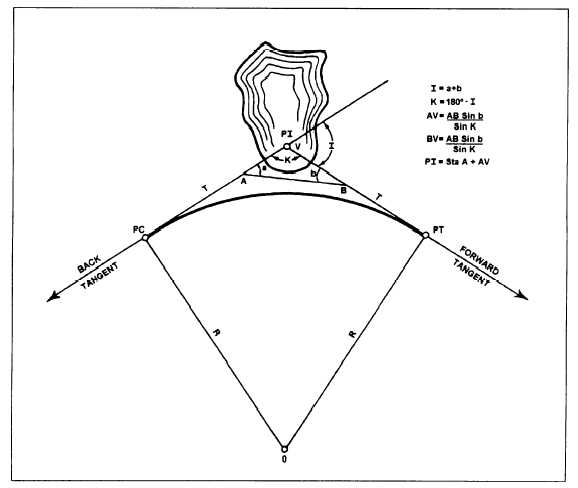This method gives an exact result. By converting the
minutes to a decimal part of a degree to the nearest fives
places, you obtain the same result.
Simple Curve Layout
To lay out the simple curve (arc definition) just
computed above, you should usually use the
procedure that follows.
1. With the instrument placed at the PI, the
instrumentman sights on the preceding PI or at a distant
station and keeps the chainman on the line while the
tangent distance is measured to locate the PC. After the
PC has been staked out, the instrumentman then trains
the instrument on the forward PI to locate the PT.
2. The instrumentman then sets up at the PC and
measures the angle from the PI to the PT. This angle
should be equal to one half of the I angle; if it is not,
either the PC or the PT has been located in the wrong
position.
3. With the first deflection angle (3°10’) set on the
as the first subchord distance (42.18 feet) is measured
from the PC.
4. Without touching the lower motion screw, the
instrumentman sets the second deflection angle (6°55’)
on the plates. The chainman measures the chord from
the previous station while the instrumentman keeps the
head chainman on line.
5. The crew stakes out the succeeding stations in
the same manner. If the work is done correctly, the last
deflection angle will point on the PT. That distance will
be the subchord length (7.79 feet) from the last station
before the PT.
When it is impossible to stake out the entire curve
from the PC, a modified method of the procedure
described above is used. Stake out the curve as far as
possible from the PC. If a station cannot be seen from
the PC for some reason, move the transit forward and
set up over a station along the curve. Pick a station for
a backsight and set the deflection angle for that station
on the plates. Sight on this station with the telescope
plates, the instrumentman keeps the chainman on line
in the reverse position. Plunge the telescope and set
Figure 11-11.—Inaccessible PI.
11-10


